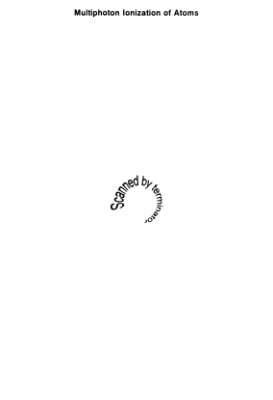Academic Press, Ontario, Canada, 1984, 272 Pages
Multiphoton ionization of atoms, molecules, and surfaces has evolved into a large field of research encompassing a wide spectrum of problems from basic to very applied. The ionization of atoms was the part of the field that began developing first and as a result is at a somewhat more advanced state at this time. Having passed the stage of qualitative understanding, the emphasis from now on will be on quantitative comparisons between theory and experiment. One aspect of such comparisons is of a spectroscopic character in that it aims at the understanding of atomic structure—especially excited states—which is impossible or extremely difficult to obtain otherwise. Another aspect has to do with the nonlinear character of the interaction itself, which brings in new physics. The large intensity within narrow bandwidths leads to significant saturation of resonant transitions; the statistical properties (coherence) of the laser radiation have a dramatic effect on the nonresonant as well as the resonant multiphoton processes. The combination of resonance with laser temporal fluctuations has in the past four years or so led to a number of surprises, especially in the context of ac Stark splitting. Thus, intermediate resonances, saturation, ac Stark shifts and splitting, and field-fluctuation effects are pivotal aspects of multiphoton processes.
''Normar' Multiphoton Ionization of Atoms (Experimental)
Theory of Multiphoton Ionization of Atoms
Calculation of Resonant Multiphoton Processes
Angular Distribution of Photoelectrons and Light Polarization Effects in Multiphoton Ionization of Atoms
Above-Threshold Ionization: Multiphoton Ionization Involving Continuum-Continuum Transitions
Multiphoton Free-Free Transitions
Multiphoton Autoionization
Creation of Doubly Charged Strontium Ions
Many-Electron Processes in Nonlinear Ionization of Atoms
Multiphoton ionization of atoms, molecules, and surfaces has evolved into a large field of research encompassing a wide spectrum of problems from basic to very applied. The ionization of atoms was the part of the field that began developing first and as a result is at a somewhat more advanced state at this time. Having passed the stage of qualitative understanding, the emphasis from now on will be on quantitative comparisons between theory and experiment. One aspect of such comparisons is of a spectroscopic character in that it aims at the understanding of atomic structure—especially excited states—which is impossible or extremely difficult to obtain otherwise. Another aspect has to do with the nonlinear character of the interaction itself, which brings in new physics. The large intensity within narrow bandwidths leads to significant saturation of resonant transitions; the statistical properties (coherence) of the laser radiation have a dramatic effect on the nonresonant as well as the resonant multiphoton processes. The combination of resonance with laser temporal fluctuations has in the past four years or so led to a number of surprises, especially in the context of ac Stark splitting. Thus, intermediate resonances, saturation, ac Stark shifts and splitting, and field-fluctuation effects are pivotal aspects of multiphoton processes.
''Normar' Multiphoton Ionization of Atoms (Experimental)
Theory of Multiphoton Ionization of Atoms
Calculation of Resonant Multiphoton Processes
Angular Distribution of Photoelectrons and Light Polarization Effects in Multiphoton Ionization of Atoms
Above-Threshold Ionization: Multiphoton Ionization Involving Continuum-Continuum Transitions
Multiphoton Free-Free Transitions
Multiphoton Autoionization
Creation of Doubly Charged Strontium Ions
Many-Electron Processes in Nonlinear Ionization of Atoms

